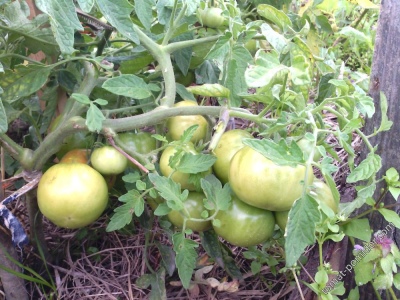
- Authors: Russia
- Category: grade
- Growth type: determinant
- Appointment: universal
- Ripening period: ultra early
- Ripening time, days: 87-95
- Growing conditions: for open ground, for film greenhouses
- Transportability: Yes
- Bush height, cm: 50-70
- Bush characteristic: bushy
Skorospelka is a tomato variety bred by Russian breeders. The plant has a determinant type of growth and an ultra-early ripening period, for which it got its name.
Description of the variety
The bush is compact, bushy, branching is average, the height reaches 50-70 cm.
The main qualities of the fruit
Ripe tomatoes have a red skin, fruit weight - up to 150 g, flat-round shape. The pulp of the tomatoes is red. Among the features, it is worth noting the good keeping quality and transportability of Skorospelka tomatoes.
Taste characteristics
According to consumers, the taste of tomatoes is sweet, but gives off sourness, the pulp is fleshy, juicy. The fruits are recommended both for fresh consumption and for canning.
Ripening and fruiting
Early ripening refers to varieties with an ultra-early ripening period, the first tomatoes can be eaten within 87-95 days after germination.
Yield
The variety is considered fruitful, but practice shows that the harvest does not always meet the wishes of gardeners and averages 5-6 kg per sq. m.
The timing of planting seedlings and planting in the ground
Sowing of seeds is carried out 55-60 days before the expected date of disembarkation at the summer cottage. The procedure follows the standard scheme:
bury the seeds 1 cm into the substrate;
cover the container with plastic wrap, put it in a warm place;
when the first shoots appear, remove the film, put the container in a lighted place;
dive seedlings at the stage of two true leaves;
a couple of weeks before transplanting, start hardening the shoots - take them outside, increasing the time spent in the fresh air every day.

Growing tomato seedlings is an extremely important process, because it largely depends on whether the gardener will be able to harvest at all. All aspects must be taken into account, from seedbed preparation to planting in the ground.
Landing scheme
It is allowed to plant tomatoes of the presented variety both in open ground and in a greenhouse. Due to the compactness of the bush, you can have up to 6 specimens per 1 m2.

Growing and care
The variety needs pinching and garter, but there is no need for shaping. And also among the advantages is Skorospelka's resistance to extreme climatic conditions. The care consists of several activities.
Watering
Held once a week, less often in rainy weather. It is recommended to irrigate in the morning or evening hours. Water the tomatoes with warm, settled water. It is better to do this by drip - the constant presence of moisture affects the harvest in a positive way, the tomatoes are more fleshy and elastic.
After irrigation, you should wait until the top layer has hardened, and then slightly loosen it so that the formed crust does not interfere with the penetration of air, fertilizers and moisture to the roots. It is important not to overflow the plant, as this threatens the appearance of cracks in the fruits, which get infections.
Loosening and hilling
Loosening is carried out 3-4 times a week, hilling - 2-3 times. Remember to remove weeds regularly.
Top dressing
Compositions that include potassium and phosphorus are suitable as fertilizers. The infusion of water and chicken droppings has proven itself well. Of the mineral fertilizers, fertilizing with boron and magnesium is effective, for example, boric acid solution.
Tying
The garter is made when 6-7 leaves appear. You can tie each bush to the support from the north side, or use a trellis, which allows you to tie bushes in pairs from two rows. The second option is preferable, since it makes it possible to pass freely between the rows. In addition, the garter leads to larger fruits.
Stepping
You need to start growing as sons a week after transplanting the seedlings, just by this moment the stepchildren reach a size of 3-4 cm.The procedure is carried out approximately once every 7 days.




A plant needs different micronutrients at each stage of growth. All fertilizers can be divided into two groups: mineral and organic. Folk remedies are often used: iodine, yeast, bird droppings, eggshells.
It is important to observe the rate and period of feeding. This also applies to folk remedies and organic fertilizers.
Disease and pest resistance
Due to the early ripening period, the plant is not afraid of many diseases, including late blight. Among insects, slugs are dangerous (ash or tobacco dust helps against them), spider mites (infusion of garlic) and bear (infusion of bitter pepper with vinegar).



























































































